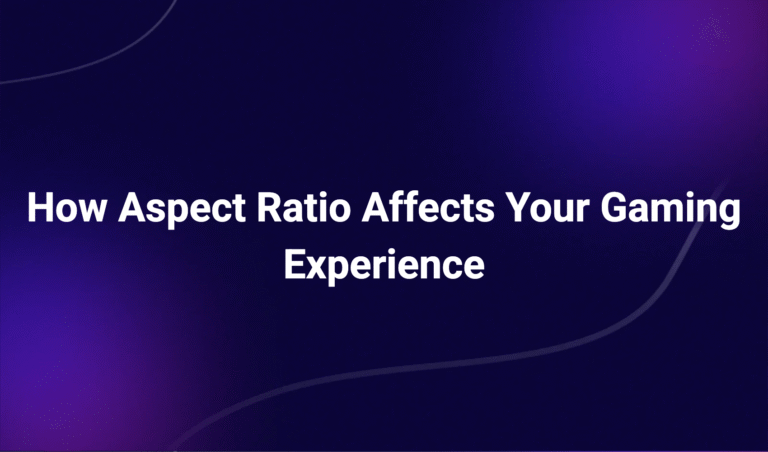Aspect Ratio Explained: What It Means for Sim Racing
Introduction: Why Aspect Ratio Shapes Everything You See
If Field of View (FOV) is the lens through which you interpret the sim world, then aspect ratio is the shape of that lens.
Aspect ratio defines the proportional relationship between the width and height of your screen. It determines how much of the game world is visible horizontally vs vertically—and how your perception of space, speed, and depth unfolds on screen.
In sim racing, this matters more than most genres. The wider your aspect ratio, the more track, environment, and opponents you can perceive—but only if it’s configured properly.
In this article, you’ll learn:
- What aspect ratio actually is (and isn’t)
- How different ratios affect your visual experience
- How aspect ratio and FOV work together
- Best aspect ratios for different types of racing setups
- How to choose the right one for your rig
What Is Aspect Ratio?
Aspect ratio is the ratio of screen width to screen height.
It’s typically expressed in two numbers, like 16:9, 21:9, or 32:9. It’s a static property of your monitor or headset and plays a defining role in:
- Screen layout
- Image stretching
- Peripheral visibility
- User interface positioning
For example:
- 16:9 means the screen is 16 units wide for every 9 units tall (standard HD/Full HD)
- 21:9 is ultrawide—21 units wide per 9 units tall (more horizontal screen real estate)
- 32:9 is super ultrawide, roughly equivalent to two 16:9 screens side by side
Common Aspect Ratios in Sim Racing
| Aspect Ratio | Resolution Example | Experience Style | Notes |
|---|---|---|---|
| 4:3 | 1024×768 | Classic square | Outdated, tight FOV |
| 16:9 | 1920×1080 | Standard widescreen | Most supported, balanced view |
| 21:9 | 3440×1440 | Ultrawide | Immersive, wider FOV |
| 32:9 | 5120×1440 | Super Ultrawide | Wraparound effect, peripheral vision gain |
| VR (Variable) | 90°–130° horizontal FOV | Immersive surround | Not fixed, dependent on headset design |
Aspect Ratio vs Resolution vs FOV: Understanding the Triad
Let’s clarify common confusion:
| Term | Definition | Example |
|---|---|---|
| Aspect Ratio | Shape of the screen (width:height) | 21:9, 16:9 |
| Resolution | Pixel count on the screen | 2560×1440 |
| Field of View (FOV) | How much of the game world is visible at once, usually in degrees | 90°, 100°, 110° |
Your aspect ratio determines how FOV is rendered across your screen.
- On a 16:9 screen, a 90° FOV may feel natural
- On a 21:9, that same 90° will stretch across more screen space
- On a 32:9, without adjusting FOV, the image may feel zoomed-in or unnatural
This is why properly calibrating FOV to match aspect ratio is crucial. Use our FOV Calculator to get it right.
How Aspect Ratio Impacts Sim Racing Experience
1. Peripheral Vision and Situational Awareness
Wider aspect ratios allow you to:
- See more of the track edges and opponents
- Predict overtaking and side-by-side movement
- Reduce the need for head-turning or look-left/right keys
2. Depth Perception and Speed Cues
Ultrawide and triple-screen setups enhance motion parallax—objects near you move faster than distant ones, improving:
- Braking accuracy
- Cornering rhythm
- Timing in traffic
But only if the aspect ratio is matched to a realistic FOV.
If not, wide screens can distort proportions and introduce unnatural spatial scaling.
3. User Interface Layout
On 21:9 or 32:9:
- HUD elements (map, delta, telemetry) may shift to the edges
- Some games may require UI scaling or mods to reposition elements
- Not all sims support extreme aspect ratios natively—always check compatibility
Pros and Cons by Aspect Ratio
16:9 – The Baseline
Pros:
- Universally supported
- Balanced view
- Easy to calibrate
Cons:
- Limited lateral awareness
- May feel “boxed in” at high speeds
21:9 – The Sweet Spot
Pros:
- Enhanced peripheral view
- Immersive cockpit simulation
- Great compromise between clarity and width
Cons:
- Some games stretch UI or cut HUD elements
- Needs more GPU power than 16:9
32:9 – For Dedicated Sim Racers
Pros:
- Ultra-wide peripheral immersion
- Simulates triple-monitor FOV in one panel
- Minimal bezel distraction
Cons:
- Not all games support natively
- May require software tricks to fix scaling
- Can distort if incorrect FOV is used
Choosing the Right Aspect Ratio: Setup Recommendations
| Setup Type | Ideal Aspect Ratio |
|---|---|
| Budget single-screen | 16:9 (1920×1080 or 2560×1440) |
| Mid-tier immersive single | 21:9 (3440×1440) |
| Competitive sim racer | Triple 16:9 or 32:9 |
| VR simulator | Variable (90–130° FOV equivalent) |
Final Thoughts: Aspect Ratio Is a Design Decision
Choosing your aspect ratio isn’t about following trends—it’s about designing a visual environment that supports performance, realism, and spatial mastery.
A narrow screen won’t teach you what’s behind.
An overly wide screen, without proper FOV calibration, might lie about what’s ahead.
Use our FOV Calculator to align your aspect ratio with your screen dimensions and seating position. Whether you’re cornering at Spa or braking at Monza, the right view makes the difference between reaction and reflex.
Dr. Vale’s content blends scientific precision with racer-focused clarity. Expect articles that don’t just explain the “how” but break down the “why” behind projection physics, spatial perception, and screen ergonomics in real-world terms. From triple screen angles to bezel compensation, Adrian’s work is grounded in empirical data and designed for competitive advantage.






